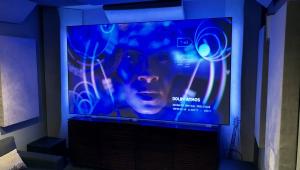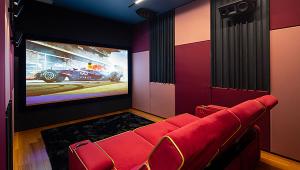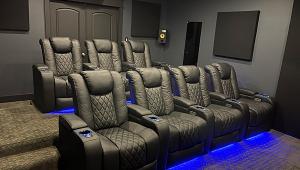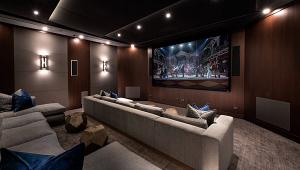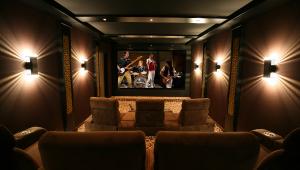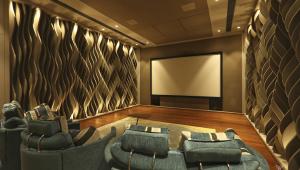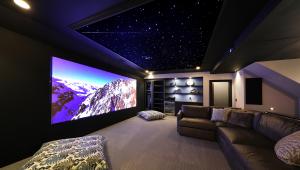Demonstrating Your Home Theater System Page 2
When it comes to sound, all really good movie theaters have something in common. You can understand the dialogue. It's the properly set-up center channel that allows you to understand the film. The center-channel speaker is the heart of your home theater universe. By some estimates, as much as 85 percent of the movie soundtrack resonates from that speaker.
You can place the center channel above or below the screen (ideally, so the tweeter is about the same height as in the left and right speakers). However, if that's not feasible, it is crucial that you tilt or aim the center-channel speaker toward the prime listening position. Little is worse than having the high frequencies fire at your ankles or over your head. It destroys the timbre and affects intelligibility. Some center-channel designs provide tilting mechanisms to properly aim the speaker. If your speaker lacks this provision, look around for one of your old VCR cassettes. With a little Scotch tape and ingenuity, they can serve as an improvised tilting platform. (Caveat: Make sure it's a videotape that you don't care about, because the magnets in the speaker could mangle what's on the tape. Also, if you have small children, large dogs, or live in earthquake country, be careful to secure the speaker properly.)
Subwoofers: Feeling the Lows
This is also known as the Goldilocks approach: not too much or too little woof. Adjusting the sub just right is a topic unto itself. That being said, here are a few things you can do to get reasonably close to just right in short order.

Audyssey MultEQ Setup System
Don't Double-Cross Yourself
All A/V receivers have subwoofer outputs that allow you to set the crossover for the woofer in the setup menu. This setting is very accurate. Once you have done that, try to avoid setting the crossover on the subwoofer itself to anything but Bypass. (The Bypass or LFE setting disables the crossover in the subwoofer so that only the receiver is filtering what goes to the sub.) If your subwoofer lacks a bypass switch or LFE input, then set the crossover control as high as it will go. We recommend this because almost all subwoofer crossover adjustments are coarse approximations, and, when you use both the filter in the receiver and on the subwoofer, the two settings battle each other, resulting in grossly uneven bass response.
The Old Subwoofer Switcharoo
In general, select a corner or a side wall and experiment with test tones and program material to ensure adequate low-frequency extension without one-note boom. Here is a tried-and-true shortcut for finding great placement for your subwoofer. Warning: Make sure that your significant other is either enthusiastic about the project or not present for this experiment. To start, place the subwoofer in your favorite chair or listening position. Now go to the wall, and while playing something with good bass, walk (or crawl) along the wall until the bass sounds really good. Lastly, swap positions with the subwoofer. Remove it from the chair, place it where you were standing, go back to the chair, and sit down. The laws of physics dictate that the woofer will now sound great from your listening position.
Getting Surrounded
When you visit a good theater, you'll notice that the surround speakers are placed on both sides of the venue. There might be a few speakers behind you, but the main surround arrays are out to your left and right. In your listening room, if at all possible, the surround speakers should also be to your left and right, preferably mounted slightly above your head (when seated). We prefer dipole speaker designs because of their diffuse soundfield and recommend this placement because it will reproduce the most convincing surround field. Many people place their surround speakers in the back of the room. Unless it is absolutely necessary, we do not recommend this placement because it could produce an acoustic hole out to your sides.
Adjusting Your System: Avoiding Messing Up All Your Hard Work
When you experience bad sound in a theater (or a home theater, for that matter), the mistakes are usually ones of excess—too much of something (or everything). An excessively loud subwoofer represents one common mistake. Everything seems punctuated with a whump—even dialogue. For some reason, theaters and/or consumers turn their subs up way too much. Why? Because they can. Another common mistake is enabling too much surround. This is a common mistake because many listeners believe that they have to hear the surround channels all the time—and at the same volume as the left, center, and right channels. Surround information should always be in the background (unless there is specific action on the screen that calls for more ambience or directional cues). You might hear rain in the jungle, traffic in the street, or wind in the desert, but nothing should distract you from the front three channels. Surrounds that are too loud will, among other things, swamp the center channel and make all of the dialogue difficult, if not impossible, to understand.

RadioShack Sound-Level Meter
Adjusting Your System
The Quick Way to Adjust Your System
Believe it or not, your ears are better adjustment tools than you ever imagined. Turn on the test tone in your receiver, and, as it circles the room, jumping from channel to channel, use the remote control to adjust the level until everything sounds about the same. Is this scientifically accurate? Absolutely not. However, it works as a reasonable estimate.
The Better Way to Adjust Your System
Buy the RadioShack analog sound-level meter. This product has been around for years, and every time RadioShack tries to replace it with their digital meter, we all kick and scream until they put it back into production. It has been discontinued at least six times in the last ten years, and they always bring it back.
Set the meter to Slow/C-Weighted and, from your seat, set all the channels until they read the same. Try pointing the business end of the meter at the ceiling and moving it back and forth slowly in front of you to obtain a spatially averaged reading. It is uncannily accurate, except in the bass. However, if you search the Internet, you will find easy-to-use charts that compensate for the bass error.
Maximizing Your Woofer Without Living in the Boom-Boom Room
We have already talked about too much woofer level. So how can you maximize low frequencies without becoming bass-centric? Here is a rule breaker. Be certain your system is otherwise configured correctly, then play your sys-
tem at normal level with a male voice (Harrison Ford's is ideal). Keep turning up the sub until you can just perceive the lower registers of his voice coming through the sub (where it does not belong). Now slowly back off the volume until his voice disappears from the sub. The sub level is now most likely at its highest usable setting, and everything in the soundtrack will be close to optimal with no perceived lower-midrange chestiness leaking from the subwoofer. While this is a handy trick with systems with a crossover frequency of roughly 100 hertz and below, it may not be as effective with HTIBs and other systems with truly tiny satellite speakers and higher crossover points.
Once you have calibrated the system, you are now ready to break the rules of your setup if you so choose. Here's an effect we enjoy, but you should experiment for yourself and see if you reach the same conclusion. If not, just reset your system to where you initially calibrated it. Our experimenting has convinced us that you can develop a great sense of acoustic space by adjusting two parameters. Turn down the calibrated center channel by as much as 2 decibels and turn up the surrounds by an equal amount. Bonus adjustment: If the center channel has a treble adjustment, or if the receiver has a dedicated tone control for the center channel only, turn it down very slightly. All of these rule-breaking adjustments tend to open up the room in a very subtle, though meaningful way. Your living room will sound a bit more expansive, yet the dialogue's intelligibility will be minimally affected.
- Log in or register to post comments
